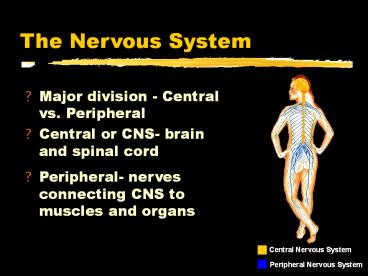The Nervous System - PowerPoint PPT Presentation
Title:
The Nervous System
Description:
The Nervous System Major division - Central vs. Peripheral Central or CNS- brain and spinal cord Peripheral- nerves connecting CNS to muscles and organs – PowerPoint PPT presentation
Number of Views:246
Avg rating:3.0/5.0
Title: The Nervous System
1
The Nervous System
- Major division - Central vs. Peripheral
- Central or CNS- brain and spinal cord
- Peripheral- nerves connecting CNS to muscles and
organs
2
Peripheral Nervous System
- 3 kinds of neurons connect CNS to the body
- sensory
- motor
- interneurons
- Motor - CNS to muscles and organs
- Sensory - sensory receptors to CNS
- Interneurons Connections Within CNS
3
Peripheral Nervous System
4
Somatic System
- Nerves to/from spinal cord
- control muscle movements
- somatosensory inputs
- Both Voluntary and reflex movements
- Skeletal Reflexes
- simplest is spinal reflex arc
5
Autonomic System
- Two divisions
- sympathetic
- Parasympatheitic
- Control involuntary functions
- heartbeat
- blood pressure
- respiration
- perspiration
- digestion
- Can be influenced by thought and emotion
6
Sympathetic
- Fight or flight response
- Release adrenaline and noradrenaline
- Increases heart rate and blood pressure
- Increases blood flow to skeletal muscles
- Inhibits digestive functions
7
Parasympathetic
- Rest and digest system
- Calms body to conserve and maintain energy
- Lowers heartbeat, breathing rate, blood pressure
8
Summary of autonomic differences
9
Central Nervous System
- Brain and Spinal Cord
10
Brain has 2 Hemispheres
- Left Right sides are separate
- Corpus Callosum major pathway between
hemispheres - Some functions are lateralized
- language on left
- math, music on right
- Lateralization is never 100
11
Each hemisphere is divided into 4 lobes
12
Sensory Information sent to opposite hemisphere
- Principle is Contralateral Organization
- Sensory data crosses over in pathways leading to
the cortex - Visual Crossover
- left visual field to right hemisphere
- right field to left
- Other senses similar
13
Contralateral Motor Control
- Movements controled by motor area
- Right hemisphere controls left side of body
- Left hemisphere controls right side
- Motor nerves cross sides in spinal cord
14
Corpus Callosum
- Major ( but not only) pathway between sides
- Connects comparable structures on each side
- Permits data received on one side to be
processed in both hemispheres - Aids motor coordination of left and right side
15
Corpus Callosum
- What happens when the corpus callosum is cut?
- Sensory inputs are still crossed
- Motor outputs are still crossed
- Hemispheres cant exchange data
16
The Split Brain studies
- Surgery for epilepsy cut the corpus callosum
- Roger Sperry, 1960s
- Special apparatus
- picture input to just one side of brain
- screen blocks objects on table from view
17
The Split Brain studies
- Picture to right brain
- cant name the object
- left hand can identify by touch
- Picture to left brain
- can name the object
- left hand cannot identify by touch
18
Localization of function
19
Occipital Lobe
- Input from Optic nerve
- Contains primary visual cortex
- most is on surface inside central fissure
- Outputs to parietal and temporal lobes
Occipital Lobe
Visual Lobe
20
Temporal Lobe
- Contains primary auditory cortex
- Inputs are auditory, visual patterns
- speech recognition
- face recognition
- word recognition
- memory formation
- Outputs to limbic System, basal Ganglia, and
brainstem
21
Parietal Lobe
- Inputs from multiple senses
- contains primary somatosensory cortex
- borders visual auditory cortex
- Outputs to Frontal lobe
- hand-eye coordination
- eye movements
- attention
22
Frontal Lobe
- Contains primary motor cortex
- No direct sensory input
- Important planning and sequencing areas
- Brocas area for speech
- Prefrontal area for working memory
23
Frontal Lobe Disorders
- Brocas area
- productive aphasia
- Prefrontal area
- lose track of ongoing context
- fail to inhibit inappropriate responses
- Often measured with the Wisconsin Card Sorting
Task
24
The Nervous System Summary
- Major structures of the nervous
- CNS, Somatic, Autonomic
- Two hemispheres 4 lobes
- Organization
- contralateral input output
- primary sensory areas
- motor areas
- Commissure
- Localization of functions































